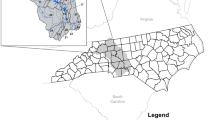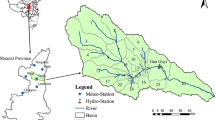Abstract
With the growing emphasis on biofuel crops and potential impacts of climate variability and change, there is a need to quantify their effects on hydrological processes for developing watershed management plans. Environmental consequences are currently estimated by utilizing computer models such as Soil and Water Assessment Tool (SWAT) to simulate watershed hydrology under projected climate and land-use scenarios to assess the effect on water quantity and/or quality. Such studies have largely been deterministic in nature, with the focus being on whether hydrologic variables such as runoff, sediment and/or nutrient loads increase or decrease from the baseline case under projected scenarios. However, studying how these changes would affect watershed health in a risk-based framework has not been attempted. In this study, impacts of several projected land-use and climate change scenarios on the health of the Wildcat Creek watershed in Indiana have been assessed through three risk indicators, namely reliability–resilience–vulnerability (R–R–V). Results indicate that cultivation of biofuel crops such as Miscanthus and switchgrass has the potential to improve risk indicator values with respect to sediment, total N and total P. Climate change scenarios that involved rising precipitation levels were found to negatively impact watershed health indicators. Trends of water quality constituents under risk-based watershed health assessment revealed nuances not readily apparent from deterministic assessments alone. For example, while biofuel crop cultivation reduced total N loads under all hypothetical land-use scenarios examined in this study, watershed vulnerability in terms of total N also rose in some of those scenarios. Risk-based analyses coupled with deterministic methods are needed for a more comprehensive assessment of the health of a watershed under projected scenarios.






Similar content being viewed by others
References
Arheimer B, Andréasson J, Fogelberg S, Johnsson H, Pers CB, Persson K (2005) Climate change impacts on water quality: model results from southern Sweden. J Hum Environ 34(7):559–566
Arnold JG, Kiniry JR, Srinivasan R, Williams JR, Haney EB, Neitsch SL Soil and water assessment tool theoretical documentation, Version 2009, 2011, Texas Water Resources Institute technical report No 365, Texas A&M University System, College Station, TX, 662 pp
Baggaley NJ, Langan SJ, Futter MN, Potts JM, Dunn SM (2009) Long-term trends in hydro-climatology of a major Scottish mountain river. Sci Total Environ 407(6):4633–4641
Carroll S, Liu A, Dawes L, Hargreaves M, Goonetilleke A (2012) Role of land use and seasonal factors in water quality degradations. Water Resour Manag 27(9):3433–3440
Chang H (2004) Water quality impacts of climate and land use changes in Southeastern Pennsylvania. Prof Geogr 56(2):240–257
Chen L, Peng H, Fu B, Qiu J, Zhang S (2005) Seasonal variation of nitrogen-concentration in the surface water and its relationship with land use in a catchment of North China. J Environ Sci 17(2):224–231
Cibin R (2013) Optimal land use planning on selection and placement of energy crops for sustainable biofuel production. PhD dissertation, Department of Agricultural and Biological Engineering, Purdue University
Cibin R, Chaubey I, Engel B (2012) Simulated watershed scale impacts of corn stover removal for biofuel on hydrology and water quality. Hydrol Process 26:1629–1641
Cruise JF, Limaye AS, Al-Abed N (1999) Assessment of impacts of climate change on water quality in the Southeastern United States. J Am Water Resour Assoc 35(6):1539–1550
Cuo L, Beyene TK, Voisin N, Su F, Lettenmaier DP, Alberti M, Richey JE (2011) Effects of mid-twenty-first century climate and land cover change on the hydrology of the Puget Sound Basin, Washington. Hydrol Process 25(11):1729–1753
Eckhardt K, Ulbrich U (2003) Potential impacts of climate change on groundwater recharge and streamflow in a central European low mountain range. J Hydrol 284(1–4):244–252
Edwards PN (2000) A brief history of atmospheric general circulation modeling. In: General circulation model development. Academic Press, San Diego, pp 67–90
Ficklin DL, Stewart IT, Maurer EP (2012) Projections of 21st century Sierra Nevada local hydrologic flow components using an ensemble of general circulation models. J Am Water Resour Assoc 68(6):1104–1125
Fiering MB, Holling CS (1974) Management and standards for perturbed ecosystems. Agro-Ecosystems 1:301–321
Fowler HJ, Blenkinsop S, Tebaldi C (2007) Linking climate change modelling to impact studies: recent advances in downscaling techniques for hydrological modelling. Int J Climatol 27:1547–1578
Franczyk H, Chang H (2009) The effects of climate change and urbanization on the runoff of the rock Creek Basin in the Portland metropolitan area, Oregon, USA. Hydrol Process 23(6):805–815
Hashimoto T, Loucks DP, Stedinger J (1982) Reliability, resilience and vulnerability for water resources system performance evaluation. Water Resour Res 18(1):14–20
Holling CS (1973) Resilience and stability of ecological systems. Ann Rev Ecolog Syst 4:1–23
Hoque YM, Tripathi S, Hantush MM, Govindaraju RS (2012) Watershed reliability, resilience and vulnerability analysis under uncertainty using water quality data. J Environ Manag 109:101–112
IDEM water quality target website. http://www.in.gov/idem/6242.htm, last accessed 2/22/2012, 1:45 pm
Jeppesen E, Kronvang B, Meerhoff M, Søndergaard M, Hansen KM, Andersen HE, Lauridsen TL, Liboriussen L, Beklioglu M, Özen A, Olesen JE (2009) Climate change effects on runoff, catchment phosphorus loading and lake ecological state, and potential adaptations. J Environ Qual 38:1930–1941
Jyrkama MI, Sykes JF (2007) The impact of climate change on spatially varying groundwater recharge in the Grand River watershed (Ontario). J Hydrol 338(3–4):237–250
Kaushal SS, Pace ML, Groffman PM, Band LE, Belt KT, Mayer PM, Welty C (2010) Land use and climate variability amplify contaminant pulses. Eos 91(25):221–222
Kim HW, Amatya DM, Chescheir GM, Skaggs WR, Nettles JE (2013) Hydrologic effects of size and location of fields converted from drained pine forest to agricultural cropland. J Hydrol Eng 18(5):552–566
Kjeldsen TR, Rosbjerg D (2004) Choice of reliability, resilience and vulnerability estimators for risk assessments of water resources systems. Hydrol Sci J 49(5):755–767
Kundzewicz ZW, Laski A (1995) Reliability-related criteria in water supply studies. In: New uncertainties concepts in hydrology and water resources. Cambridge University Press, Cambridge, pp 299–305
Loucks OL (1977) Emergence of research on agro-ecosystems. Annu Rev Ecol Syst 8:173–192
Khoi DN, Suetsugi T (2012) The responses of hydrological processes and sediment yield to land-use and climate change in the Be River catchment, Vietnam. Hydrol Process. doi:10.1002/hyp.9620
Maringanti C (2010) Assessment of uncertainty in optimal management to control nonpoint source pollution from agricultural watersheds. PhD dissertation, Department of Agricultural and Biological Engineering, Purdue University, 250 pp
McIsaac GF, David MB, Mitchell CA (2010) Miscanthus and switchgrass production in central Illinois: impacts on hydrology and inorganic nitrogen leaching. J Environ Qual 39(5):1790–1799
Mimikou MA, Baltas E, Varanou E, Pantazis K (2000) Regional impacts of climate change on water resources quantity and quality indicators. J Hydrol 234(1–2):95–109
Mishra V, Lettenmaier DP (2011) Climatic trends in major US urban areas, 1950–2009. Geophysical Research Letters 38. doi:10.1029/2011GL048255
Mondal MS, Chowdhury JU, Ferdous MR (2009) Risk based evaluation for meeting future water demand of the Brahmaputra floodplain within Bangladesh. Water Resour Manag 24(5):853–869
Naeem S (1998) Species redundancy and ecosystem reliability. Conserv Biol 12(1):39–45
National Resources Conservation Services (NRCS) (2008) Rapid watershed assessment wildcat watershed. www.in.nrcs.usda.gov/technical/RWA/Wildcat/Wildcat.pdf, 17 pp
Parker DE (2006) A demonstration that large-scale warming is not urban. J Climate 19:2882–2895
Peterson TC (2003) Assessment of urban versus rural in situ surface temperatures in the contiguous United States: no difference found. J Climate 16(18):2941–2959
Rehana S, Mujumdar PP (2011) River water quality response under hypothetical climate change scenarios in Tunga-Bhadra river, India. Hydrol Process 25(22):3373–3386
Sallu SM, Twyman C, Stringer LC (2010) Resilient or vulnerable livelihoods? Assessing livelihood dynamics and trajectories in rural Botswana. Ecology and Society 15(4). 24 pp
Shi P, Ma X, Hou Y, Li Q, Zhang Z, Qu S, Chen C, Cai T, Fang X (2013) Effects of land-use and climate change on hydrological processes in the upstream of Huai river, China. Water Resour Manag 27(5):1263–1278
Sinha T, Cherkauer KA (2010) Impacts of future climate change on soil frost in the Midwestern United States. J Geophys Res 115 (D8), 16 pp (published online)
Stonefelt MD, Fontaine TA, Hotchkiss RH (2000) Impacts of climate change on water yield in the upper wind river basin. J Am Water Resour Assoc 36(2):321–336
SWAT literature database website. https://www.card.iastate.edu/swat_articles/, last accessed 10/25/2012, 3:20 pm
Tu J (2009) Combined impact of climate and land use changes on streamflow and water quality in Eastern Massachusetts, USA. J Hydrol 379(3–4):268–283
United States Department of Agriculture (USDA) (2010) USDA biofuels strategic report: a USDA roadmap to metting the biofuel goals of the renewable fuels standard by 2022. http://www.usda.gov/documents/USDA_Biofuels_Report_6232010.pdf, 21 pp
Vitousek PM, Mooney HA, Lubchenco J, Melillo JM (1997) Human domination of earth’s ecosystems. Science 277(5324):494–499
Walker B, Holling CS, Carpenter SR, Kinzig A (2004) Resilience, adaptability and transformability in social-ecological systems. Ecol Soc 9(2). 5 pp
Whitehead PG, Wilby RL, Battarbee RW, Kernan M, Wade AJ (2009) A review of the potential impacts of climate change on surface water quality. Hydrol Sci J 54(1):101–123
Yong STY, Chen W (2002) Modeling the relationship between land use and surface water quality. J Environ Manag 66(4):377–393
Zhou L, Dickinson RE, Tian Y, Fang J, Li Q, Kaufmann RK, Tucker CJ, Myneni RB (2004) Evidence for a significant urbanization effect in China. Proc Natl Acad Sci USA 101(26):9540–9544
Acknowledgements
The U.S. Environmental Protection Agency through its Office of Research and Development funded and managed the research described here under EPA Contract # EP-C-11-006. It has not been subjected to Agency review and therefore does not necessarily reflect the views of the Agency, and no official endorsement should be inferred.
Author information
Authors and Affiliations
Corresponding author
Rights and permissions
About this article
Cite this article
Hoque, Y.M., Raj, C., Hantush, M.M. et al. How Do Land-Use and Climate Change Affect Watershed Health? A Scenario-Based Analysis. Water Qual Expo Health 6, 19–33 (2014). https://doi.org/10.1007/s12403-013-0102-6
Received:
Revised:
Accepted:
Published:
Issue Date:
DOI: https://doi.org/10.1007/s12403-013-0102-6




